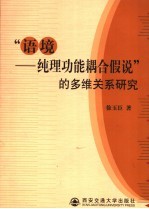图书介绍
“语境-纯理功能耦合假说”的多维关系研究PDF|Epub|txt|kindle电子书版本网盘下载

- 徐玉臣著 著
- 出版社: 西安:西安交通大学出版社
- ISBN:7560523218
- 出版时间:2006
- 标注页数:280页
- 文件大小:8MB
- 文件页数:304页
- 主题词:语境特征-研究
PDF下载
下载说明
“语境-纯理功能耦合假说”的多维关系研究PDF格式电子书版下载
下载的文件为RAR压缩包。需要使用解压软件进行解压得到PDF格式图书。建议使用BT下载工具Free Download Manager进行下载,简称FDM(免费,没有广告,支持多平台)。本站资源全部打包为BT种子。所以需要使用专业的BT下载软件进行下载。如BitComet qBittorrent uTorrent等BT下载工具。迅雷目前由于本站不是热门资源。不推荐使用!后期资源热门了。安装了迅雷也可以迅雷进行下载!
(文件页数 要大于 标注页数,上中下等多册电子书除外)
注意:本站所有压缩包均有解压码: 点击下载压缩包解压工具
图书目录
Chapter One Introduction1
1.1 Theoretical backgrounds of the present study1
1.2 The objectives of the present study7
1.3 The organization of the book12
Chapter Two The Notion of Context Revisited14
2.1 Introduction14
2.2 The socio-cultural approach to context of situation18
2.2.1 The concept of context in pragmatics18
2.2.1.1 Leech's view of speech situation19
2.2.1.2 van Dijk's notion of context20
2.2.1.3 Hymes'concept of speech situation:SPEAKING22
2.2.1.4 Lyons'context of utterance24
2.2.1.5 Gazdar's view of context26
2.2.2 Context in Systemic Functional Linguistics27
2.2.2.1 Context of situation in the pre-Halliday era(1):Malinowski's view27
2.2.2.2 Context of situation in the pre-Halliday era(2):Firth's view29
2.2.2.3 Context of situation as a socio-semiotic construct:the notion in SFL31
2.3 The cognitive approach to the notion of context34
2.3.1 Context as cognitive representation of the conceptual interaction35
2.3.2 Context as domain36
2.3.3 Context as frame37
2.3.4 Context as script39
2.4 The notion of context of situation in SFL revisited40
2.4.1 Field of discourse40
2.4.2 Tenor of discourse45
2.4.3 Mode of discourse48
2.5 Summary50
Chapter Three Language Functions and Their Realizations53
3.1 Introduction53
3.2 Traditional views of language functions56
3.2.1 Jakobson's categorization of language functions56
3.2.2 Hymes'model of language functions59
3.2.3 Brown&Yule's dichotomy61
3.3 Metafunctions and their grammatical realizations63
3.3.1 The ideational metafunction and its grammatical realization66
3.3.1.1 Classification of processes67
3.3.1.2 Internal structure of the process69
3.3.2 The interpersonal metafunction and its grammatical realization71
3.3.2.1 Mood71
3.3.2.2 Modality76
3.3.3 The textual metafunction and its realization78
3.3.3.1 Structural resources79
3.3.3.2 Non-structural resources:cohesive devices84
3.4 Rethinking linguistic realizations of metafunctions91
3.4.1 The ideational metafunction and its lexical realization92
3.4.2 The interpersonal metafunction and its other realizations94
3.4.3 The textual metafunction and nominalization98
3.5 Summary100
Chapter Four CMH Hypothesis Revisited103
4.1 Introduction103
4.2 CMH hypothesis106
4.3 Field of discourse and ideational metafunction108
4.3.1 Action-based vs. reflection-based fields108
4.3.2 Specialized vs. non-specialized fields115
4.3.3 Institutionalized vs. non-institutionalized fields119
4.4 Tenor of discourse and interpersonal metafunction122
4.4.1 Social distance and interpersonal metafunction122
4.4.2 Affective involvement and interpersonal metafunction125
4.4.3 Power and interpersonal metafunction127
4.5 Mode of discourse and textual netafunction129
4.5.1 Spontaneity and textual metafunction129
4.5.2 Spatial/temporal distance and textual metafunction134
4.5.3 Semiotic role and textual metafunction138
4.6 Rethinking CMH Hypothesis141
4.7 Summary143
Chapter Five Interaction between Contextual Variables146
5.1 Introduction146
5.2 Impact of field upon tenor147
5.2.1 Impact of subject matter upon tenor148
5.2.2 Impact of arena upon tenor152
5.2.3 Impact of semantic domain upon tenor155
5.3 Impact of field upon mode158
5.3.1 Impact of subject matter upon mode159
5.3.2 Impact of arena upon mode162
5.3.3 Impact of semantic domain upon mode164
5.4 Impact of tenor upon field168
5.4.1 Impact of social distance upon field168
5.4.2 Impact of power upon field173
5.4.3 Impact of affective involvement upon field176
5.5 Impact of tenor upon mode177
5.5.1 Impact of affective involvement upon mode178
5.5.2 Impact of social distance upon mode179
5.6 Impact of mode upon field182
5.6.1 Impact of semiotic role upon field182
5.6.2 Impact of spatial/temporal distance upon field185
5.6.3 Impact of channel upon field186
5.7 Impact of mode upon tenor188
5.7.1 Impact of spontaneity upon tenor189
5.7.2 Impact of genre upon tenor191
5.8 Summary194
Chapter Six CMH Hypothesis Revised:Multivariate Relation-ships between Contextual Variables and Metafunctions198
6.1 Introduction198
6.2 Impact of field upon interpersonal choices200
6.2.1 Impact of field upon the selection of vocatives200
6.2.2 Impact of field upon code-switching201
6.2.3 Impact of field upon choices in mood202
6.2.4 Impact of field upon choices in modality206
6.3 Impact of field upon textual choices210
6.3.1 Impact of field upon choices in the Thematic structure210
6.3.2 Impact of field upon nominalization214
6.4 Impact of tenor upon ideational choices216
6.4.1 Impact of tenor upon the selection of the process per se217
6.4.2 Impact of tenor upon the choice of participants and circumstances220
6.5 Impact of tenor upon textual choices224
6.5.1 Impact of tenor upon the employment of nominalization224
6.5.2 Impact of tenor upon thematic choices227
6.6 Impact of mode upon ideational choices233
6.6.1 Impact of spontaneity upon ideational choices234
6.6.2 Impact of the semiotic role of text upon ideational choices237
6.7 Impact of mode upon interpersonal choices240
6.7.1 Impact of spontaneity upon the choice of marked mood structures240
6.7.2 Impact of spontaneity upon the choice of partial mood structures244
6.8 Summary246
Chapter Seven Conclusions249
Bibliography259
Appendix Ⅰ Specialized discourses selected for analysis277
Appendix Ⅱ Non-specialized discourses selected for analysis280